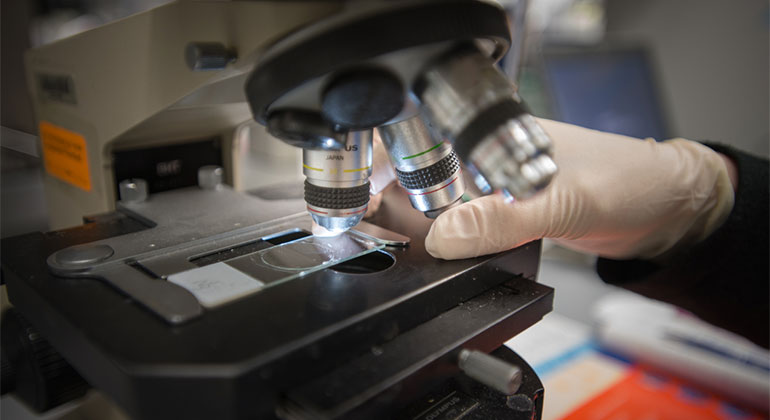Mount Sinai Researchers Discover New Way Cells Control RNA Production

Scientists at the Icahn School of Medicine at Mount Sinai have made an exciting discovery about how human cells make RNA, a molecule that carries important instructions inside our bodies.
RNA functions as a set of blueprints that tell cells how to build proteins, which help bodies grow and stay healthy. But, before RNA can do its job, it has to be made correctly inside the cell. The Mount Sinai scientists found that a special helper protein called SPT5 plays a big role in this process.
In a new study published in the latest issue of Molecular Cell, a team led by Robert P. Fisher, MD, PhD, Professor of Oncological Sciences at the Icahn School of Medicine at Mount Sinai, discovered that SPT5 makes sure RNA is copied accurately and efficiently. However, SPT5 does not work alone—it needs to be activated at just the right moment.
The researchers found that an enzyme called CDK9 acts like a traffic controller, adding chemical tags called phosphates onto different parts of the SPT5 protein—a process called phosphorylation. These tags, which are placed on specific regions containing phosphorylation sites, turn SPT5 on and off at key stages of the RNA-making process.
Two such regions, named CTR1 and CTR2, were thought to perform similar jobs. However, the Mount Sinai team discovered something surprising: these sites actually have opposing functions that control how fast RNA is copied from DNA. In other words, CTR1 acts like an accelerator, helping the process move quickly; while CTR2 works like a brake, slowing things down to ensure accuracy.
“Our findings challenge the previous assumption that CTR2 was redundant with CTR1,” said Dr. Fisher. “Instead, we discovered that these phosphorylation sites work together but have distinct and opposing effects on RNA polymerase II elongation speed and the output of RNA.”
The study used an innovative chemical genetic approach in human colon cancer cells (HCT116) to systematically manipulate SPT5 phosphorylation and analyze its effects on transcriptional pausing, elongation, and termination. Key discoveries include:
- Phosphorylation of CTR1 and CTR2 acts as an “accelerator and brake” system to regulate elongation speed.
- Blocking CTR1 phosphorylation caused the RNA-copying machinery to slow down, resulting in reduced "nascent transcription", meaning fewer new RNA molecules were being made.
- Mutation of both CTR1 and CTR2 had additive effects on splicing, termination, and cell proliferation, underscoring the critical role of coordinated SPT5 phosphorylation in maintaining gene expression and cell viability.
These insights could have major implications for diseases like cancer, where gene expression goes awry. By better understanding how SPT5 is regulated, scientists may be able to develop new drugs that fine-tune RNA production in cells.
About the Icahn School of Medicine at Mount Sinai
The Icahn School of Medicine at Mount Sinai is internationally renowned for its outstanding research, educational, and clinical care programs. It is the sole academic partner for the seven member hospitals* of the Mount Sinai Health System, one of the largest academic health systems in the United States, providing care to New York City’s large and diverse patient population.
The Icahn School of Medicine at Mount Sinai offers highly competitive MD, PhD, MD-PhD, and master’s degree programs, with enrollment of more than 1,200 students. It has the largest graduate medical education program in the country, with more than 2,600 clinical residents and fellows training throughout the Health System. Its Graduate School of Biomedical Sciences offers 13 degree-granting programs, conducts innovative basic and translational research, and trains more than 560 postdoctoral research fellows.
Ranked 11th nationwide in National Institutes of Health (NIH) funding, the Icahn School of Medicine at Mount Sinai is among the 99th percentile in research dollars per investigator according to the Association of American Medical Colleges. More than 4,500 scientists, educators, and clinicians work within and across dozens of academic departments and multidisciplinary institutes with an emphasis on translational research and therapeutics. Through Mount Sinai Innovation Partners (MSIP), the Health System facilitates the real-world application and commercialization of medical breakthroughs made at Mount Sinai.
-------------------------------------------------------
* Mount Sinai Health System member hospitals: The Mount Sinai Hospital; Mount Sinai Brooklyn; Mount Sinai Morningside; Mount Sinai Queens; Mount Sinai South Nassau; Mount Sinai West; and New York Eye and Ear Infirmary of Mount Sinai.
About the Mount Sinai Health System
Mount Sinai Health System is one of the largest academic medical systems in the New York metro area, employing 48,000 people across its hospitals and more than 400 outpatient practices, as well as more than 600 research and clinical labs, a school of nursing, and a leading school of medicine and graduate education. Mount Sinai advances health for all people, everywhere, by taking on the most complex health care challenges of our time—discovering and applying new scientific learning and knowledge; developing safer, more effective treatments; educating the next generation of medical leaders and innovators; and supporting local communities by delivering high-quality care to all who need it.
Through the integration of its hospitals, labs, and schools, Mount Sinai offers comprehensive health care solutions from birth through geriatrics, leveraging innovative approaches such as artificial intelligence and informatics while keeping patients’ medical and emotional needs at the center of all treatment. The Health System includes approximately 9,000 primary and specialty care physicians and 11 free-standing joint-venture centers throughout the five boroughs of New York City, Westchester, Long Island, and Florida. Hospitals within the System are consistently ranked by Newsweek’s® “The World’s Best Smart Hospitals, Best in State Hospitals, World Best Hospitals and Best Specialty Hospitals” and by U.S. News & World Report's® “Best Hospitals” and “Best Children’s Hospitals.” The Mount Sinai Hospital is on the U.S. News & World Report® “Best Hospitals” Honor Roll for 2024-2025.
For more information, visit https://www.mountsinai.org or find Mount Sinai on Facebook, Twitter and YouTube.